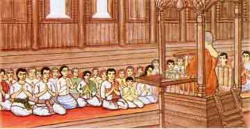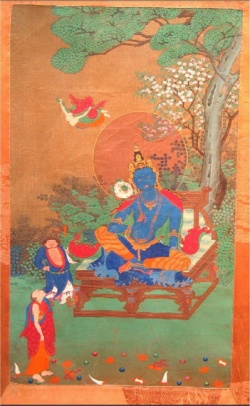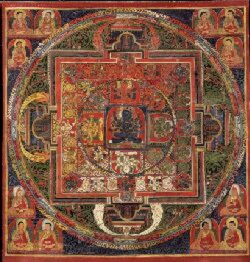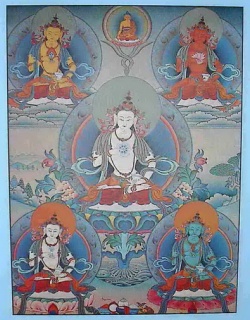Zhangzhung
Zhang Zhung, Shang Shung, or Tibetan Pinyin Xang Xung, was an ancient culture and kingdom of western and northwestern Tibet, which pre-dates the culture of Tibetan Buddhism in Tibet. Zhang Zhung culture is associated with the Bon Religion, which in turn, has influenced the philosophies and practices of Tibetan Buddhism. The Zhang Zhung are mentioned frequently in ancient Tibetan texts as the original rulers of central and western Tibet. Only in the last two decades have archaeologists been given access to do archaeological work in the areas once ruled by the Zhang Zhung.
Recently, a tentative match has been proposed between the Zhang Zhung and an Iron Age culture now being uncovered on the Chang Tang plateau of northwestern Tibet.
Kingdoms in 565 AD.
According to Annals of Lake Manasarowar (Lake Manasarovar), at one point the Zhang Zhung civilization consisted of 18 kingdoms in the west and northwest portion of Tibet. The Zhang Zhung culture was centered around Sacred Mount Kailash and extended west to Sarmatians and present-day Ladakh & Baltistan, southwest to Jalandhar, south to the Kingdom of
Mustang in Nepal, east to include central Tibet, and north across the vast Chang Tang plateau and the Taklamakan Desert to Shanshan. Thus the Zhang Zhung culture controlled the major portion of the "roof of the World".
Tradition has it that Zhang Zhung consisted "of three different regions: sGob-ba, the outer; Phug-pa, the inner; and Bar-ba, the middle. The outer is what we might call Western Tibet, from Gilgit in the west to Dangs-ra khyung-rdzong in the east, next to lake gNam-mtsho, and from Khotan in the north to Chu-mig brgyad-cu rtsa-gnyis in the south. The inner region is said to be sTag-gzig (Tazig) [often identified with Bactria], and the middle rGya-mkhar bar-chod, a place not yet identified." While it is not certain whether Zhang Zhung was really so large, it is known that it was an independent kingdom and covered the whole of Western Tibet.
The capital city of Zhang Zhung was called Khyunglung (Khyunglung Ngülkhar]] or 88Khyung-lung dngul-mkhar9]), the "Silver Palace of Garuda", southwest of Mt Kailash (Mount Ti-se), which is identified with palaces found in the upper Sutlej Valley.
The Zhang Zhung built a towering fort, Chugtso Dropo, on the shores of sacred Lake Dangra, from which they exerted military Power over the surrounding district in central Tibet.
The fact that some of the ancient texts describing the Zhang Zhung kingdom also claimed the Sutlej valley was Shambhala, the land of Happiness (from which James Hilton possibly derived the name "Shangri La"), may have delayed their study by Western scholars. According to Rolf Alfred Stein author of Tibetan Civilization, the area of Shang Shung was not historically a part of Tibet and was a distinctly foreign territory to the Tibetans. According to Rolf Alfred Stein, “…Then further west, The Tibetans encountered a distinctly foreign nation. - Shangshung, with its capital at Khyunglung. Mt. Kailāśa (Tise ) and Lake Manasarovar formed part of this country., whose Language has come down to us through early documents. Though still unidentified, it seems to be Indo European. …
Geographically The country was certainly open to India, both through Nepal and by way of Kashmir and Ladakh. Kailāśa is a holy place for the Indians, who make pilgrimages to it. No one knows how long they have done so, but the cult may well go back to the times when Shangshung was still independent of Tibet. How far Shangshung stretched to the north , east and west is a mystery…. We have already had an occasion to remark that Shangshung, embracing Kailāśa sacred Moun of the Hindus, may once have had a Religion largely borrowed from Hinduism. The situation may even have lasted for quite a long time. In fact, about 950, the Hindu King of Kabul had a statue of Vişņu, of the Kashmiri type (with three heads), which he claimed had been given him by the king of the Bhota (Tibetans) who, in turn had obtained it from Kailāśa.”
The Territorial Extent of Ladakh during the period of King Nyimagon about 975 A. D.- 1000 A.D. as depicted in A History of Western Tibet by A.H. Francke, 1907
The empire of King Tsewang Rnam Rgyal 1., and that of King Jamyang Rnam Rgyal., about 1560 and 1600 A.D
A chronicle of Ladakh compiled in the 17th century called the La dvags rgyal rabs, meaning the Royal Chronicle of the Kings of Ladakh recorded that this boundary was traditional and well-known. The first part of the Chronicle was written in the years 1610 -1640, and the second half towards the end of the 17th century. The work has been translated into English by A. H. Francke and published in 1926 in Calcutta titled the “Antiquities of Indian Tibet” . In volume 2, the Ladakhi Chronicle describes the partition by King Sykid-Ida-ngeema-gon of his kingdom between his three sons, and then the chronicle described the extent of territory secured by that son.
The following quotation is from page 94 of this book: "He gave to each of his sons a separate kingdom, viz., to the eldest Dpal-gyi-ngon, Maryul of Mnah-ris, the inhabitants using black bows; ru-thogs of the east and the Gold-mine of Hgog; nearer this way Lde-mchog-dkar-po; at the frontier ra-ba-dmar-po; Wam-le, to the top of the pass of the Yi-mig rock…..” From a perusal of the aforesaid work, It is obvious and evident that Rudokh was an integral part of Ladakh and even after the family partition, Rudokh continued to be part of Ladakh. Maryul meaning lowlands was a name given to a part of Ladakh. Even at that time, i.e. in the 10th century, Rudokh was an integral part of Ladakh and Lde-mchog-dkar-po, i.e. Demchok was also an integral part of Ladakh.
History of the Zhangzhung
Paleolithic findings
Pollen and tree ring analysis indicates the Chang Tang plateau was a much more livable environment until becoming drier and colder starting around 1500 BC. One theory is that the civilization established itself on the plateau when conditions were less harsh, then managed to persist against gradually worsening climatic conditions until finally expiring around 1000 AD (the area is now used only by nomads). This timeframe also corresponds to the rise of the Tibetan kingdoms in the southern valleys which may also have contributed to the decline of the plateau culture.
Iron Age culture of the Chang Tang — the Zhang Zhung?
Recent archeological work on the Chang Tang plateau finds evidence of an Iron Age culture which some have tentatively identified as the Zhangzhung. This culture is notable for the following characteristics:
a system of hilltop stone forts or citadels, likely used as a defense against the steppe tribes of [[Wikipedia:Central Asia|Central Asia]], such as the Scythians
burial complexes which use vertical tombstones, occasionally in large arrays, and including up to 10,000 graves in one location
stone temples located in the mountains adjacent to the plains, characterized by windowless rooms, corbelled stone roofs, and round walls
evidence of a stratified social structure, as indicated by royal or princely tombs
petroglyphs which shows the culture was a warrior horse culture
These characteristics more closely match the Iron Age cultures of Europe and the Asian steppes than those of India or East Asia, suggesting a cultural influence which arrived from the west or north rather than the east or south.
The Conquest of Zhangzhung
There is some confusion as to whether Central Tibet conquered Zhangzhung during the reign of Songtsän Gampo (605 or 617? - 649) or in the reign of Trisong Detsen (Wylie: Khri-srong-lde-btsan), (r. 755 until 797 or 804 CE). The records of the Tang Annals do, however, seem to clearly place these events in the reign of Songtsän Gampo for they say that in 634, Yangtong (Zhang Zhung) and various Qiang tribes "altogether submitted to him."
Following this he united with The country of Yangtong to defeat the 'Azha or Tuyuhun, and then conquered two more tribes of Qiang before threatening Songzhou with an army of more than 200,000 men. He then sent an envoy with gifts of gold and silk to the Chinese emperor to ask for a Chinese princess in marriage and, when refused, attacked Songzhou. He apparently finally retreated and apologised and later the emperor granted his request.
Early Tibetan accounts say that the Tibetan king and the king of Zhangzhung had married each other's sisters in a political alliance. However, the Tibetan wife of the king of the Zhangzhung complained of poor treatment by the king's principal wife. War ensued, and through the treachery of the Tibetan princess, "King Ligmikya of Zhangzhung, while on his way to Sum-ba (Amdo province) was ambushed and killed by King Srongtsen Gampo's soldiers. As a consequence, the Zhangzhung kingdom was annexed to Bod [Central Tibet]. Thereafter the new kingdom born of the unification of Zhangzhung and Bod was known as Bod rGyal-khab." R. A. Stein places the conquest of Zhangzhung in 645.
Revolt of Zhang Zhung in 677 CE
Zhang Zhung revolted soon after the Death of King Mangsong Mangtsen or Trimang löntsän (Khri-mang-slon-rtsan, r. 650-677), the son of Songtsän Gampo, but was brought back under Tibetan control by the "firm Governance of the great leaders of the Mgar clan".
The Zhangzhung Language
A handful of Zhangzhung texts and 11th century bilingual Tibetan documents attest to a Zhangzhung Language which was related to Kinnauri. The Bonpo claim that the Tibetan Writing system is derived from the Zhangzhung alphabet, while modern scholars recognize the clear derivation of Tibetan script from a North Indian script, which accords with non-Bon Tibetan accounts. A modern Kinnauri Language called by the same name (pronounced locally Jangshung) is spoken by 2,000 people in the Sutlej Valley of Himachal Pradesh who claim to be descendants of the Zhangzhung.
Zhangzhung culture's influence in India
It is noteworthy that the Bonpo tradition claims that it was founded by a Buddha-like figure named Tonpa Shenrab Miwoche, to whom are ascribed teachings similar in scope to those ascribed to the historical Buddha. Bonpos claim that Tonpa Shenrab Miwoche lived some 18,000 years ago, and visited Tibet from the land of Tagzig Olmo Lung Ring, or Shambhala.
Bonpos also suggest that during this time Lord Shenrab Miwoche's teaching permeated the entire subcontinent and was in part responsible for the development of the Vedic Religion. An example of this link is said to be Mt Kailash, which is the center of Zhang Zhung culture, and also the most sacred mountain to Hindus. As a result, the Bonpos claim that the supposedly much later teaching at least indirectly owes its origin to Tonpa Shenrab Miwoche.



